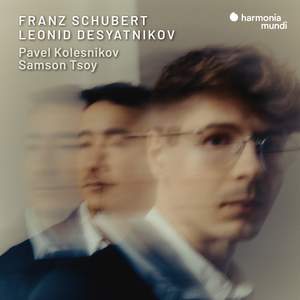SCHUBERT; DESYATNIKOV Works for Piano Duet
View record and artist detailsRecord and Artist Details
Genre:
Instrumental
Label: Harmonia Mundi
Magazine Review Date: 07/2024
Media Format: CD or Download
Media Runtime: 68
Mastering:
DDD
Catalogue Number: HMM90 2716

Tracks:
| Composition | Artist Credit |
|---|---|
| Trompe-l’œil |
Leonid Desyatnikov, Composer
Pavel Kolesnikov, Piano Samson Tsoy, Piano |
| Divertissement à la Hongroise |
Franz Schubert, Composer
Pavel Kolesnikov, Piano Samson Tsoy, Piano |
| Fantasie |
Franz Schubert, Composer
Pavel Kolesnikov, Piano Samson Tsoy, Piano |
Author: Patrick Rucker
Pavel Kolesnikov and Samson Tsoy, who have lived and played together since student days, have released a conceptually tantalising album for piano four hands. It features two large works by the foremost master of the medium: Schubert’s Hungarian Divertissement from 1824 and one of the masterpieces from the last year of his life, the F minor Fantasy. These are juxtaposed with a work premiered just last year at Aldeburgh by the Russian composer Leonid Desyatnikov called Trompe-l’œil. Desyatnikov (b1955 in Kharkiv, Ukraine) may be best known for his scores to some 14 films but he has also written four operas, a number of cantatas and other vocal works, a ballet and a symphony. He conceived Trompe-l’œil as a ‘reflection’ of the F minor Fantasy. ‘You can envisage my piece as the follow-up, or the rough draft of Schubert’s Fantasy. Like a study for a composition that’s been abandoned’, Desyatnikov states in the booklet. In fact, both Trompe-l’œil and the Fantasy are about the same length and Trompe-l’œil is built almost entirely on elements in the Schubert, save the opening theme.
It should be said upfront that Kolesnikov and Tsoy share a unity of musical intent, perfectly matched finesse and nuance, and beautifully coordinated pianistic resources that make their hand-in-glove ensemble a joy to experience. Desyatnikov’s piece is richly detailed and sharply focused. Its Schubertian inspirations are always obvious, without ever being overstated or laboured. Kolesnikov and Tsoy’s approach to the piece is so immersive, as well as deeply artistic, that the work is immediately appealing, yet its interest grows in subsequent hearings.
Their reading of the much-abused F minor Fantasy is at once so sensitive and personal that the power and dignity of the work sacrificed by well-meaning amateurs is fully restored. They take the opening Allegro molto moderato very leisurely indeed, recalling one of the very slowest, by Vronsky and Babin mid-20th century. The Scherzo is colourful and lively, while both the Largo and the finale are models of polyphonic poise and clarity. This is an original performance that rewards repeated listening.
The Hungarian Divertissement, a fruit of the summer Schubert spent as music master at the Esterházy household in Zselis, is unfortunately less convincing, primarily due to an uncertain approach to early 19th-century Hungarian style. One feels that the character of many of the thematic areas in the opening Andante is misjudged, occasionally destabilising this most rhapsodic of the three movements. The March, marked Andante con moto, careers forwards precipitously. In cadential measures, Schubert sometimes accents both the first and second beats. Here, however, the first beat is often neglected, placing an inexplicable emphasis on the second. Meanwhile, the finale, an Allegretto, is out of the gate at an unstoppable Presto vivace, distorting the character of the principal melody throughout.
Yet, with so much that’s beyond excellent and deeply pleasurable in this recording, complaint diminishes to a quibble.
Discover the world's largest classical music catalogue with Presto Music.

Gramophone Digital Club
- Digital Edition
- Digital Archive
- Reviews Database
- Full website access
From £8.75 / month
Subscribe
Gramophone Full Club
- Print Edition
- Digital Edition
- Digital Archive
- Reviews Database
- Full website access
From £11.00 / month
Subscribe
If you are a library, university or other organisation that would be interested in an institutional subscription to Gramophone please click here for further information.




